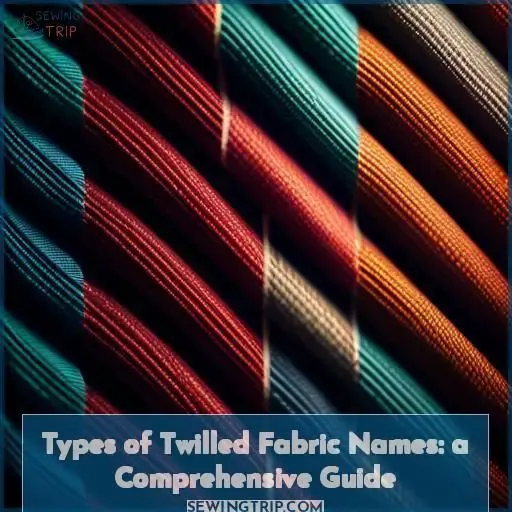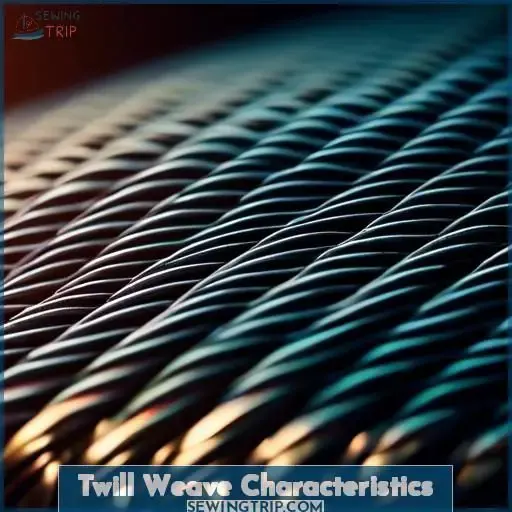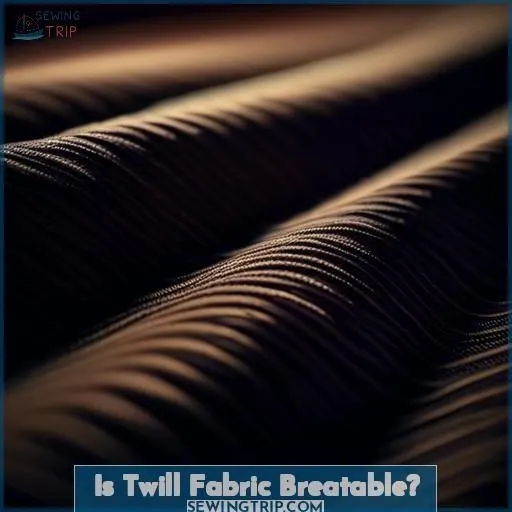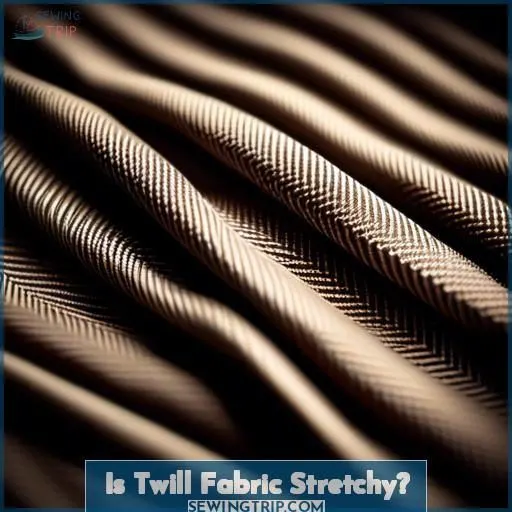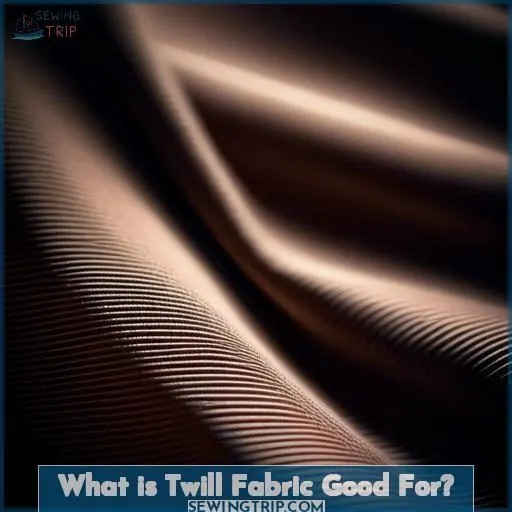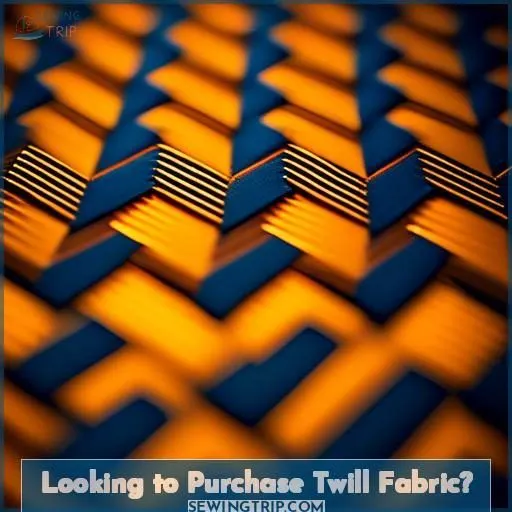This site is supported by our readers. We may earn a commission, at no cost to you, if you purchase through links.
When exploring types of twilled fabric names, you’ll find a diverse range, each with distinct characteristics. Twill weave, famous for its diagonal lines, is not merely durable and versatile but also comes in various fibers, enhancing the visual textures and styles. From the airy linen and cotton twill to the warmer wool twill, and even stretchy twill fabrics that blend natural with synthetic fibers, there’s a twill for every demand.
Whether you’re contemplating denim, chinos, or upholstery, knowing the specific types such as zigzag, herringbone, and diamond twill can direct your decision. Further exploration will expose the full potential of twill fabrics in your projects.
Table Of Contents
Key Takeaways
- Twill fabric is characterized by its diagonal lines and is known for its durability and versatility.
- Twill fabric comes in various fibers, including cotton, polyester, and wool, each with its own unique properties and characteristics.
- Twill fabric’s breathability varies depending on the fiber type and thickness. Linen or cotton twill is more breathable than polyester twill, while wool twill is warmer.
- Stretch twill fabrics exist, providing enhanced comfort and flexibility by blending natural fibers like cotton with synthetic counterparts like spandex or elastane.
Twill Weave Characteristics
Twill weave is a popular fabric weave characterized by its diagonal lines, resulting from weft threads passing over warp threads. This technique has been used for thousands of years, with twill fabric being one of the three original types of textile weaves.
Twill fabric is known for its durability and versatility, making it suitable for a wide range of applications. It can be made from various fiber types, including cotton, polyester, and wool, each with its own unique properties and characteristics.
The twill pattern can vary from the classic zigzag to herringbone and diamond, offering a range of visual textures and styles.
Is Twill Fabric Breatable?
Twill fabric’s breathability varies depending on the fiber type and thickness. Linen or cotton twill is more breathable than polyester twill. Wool twill is warmer than other twill fabrics.
To improve breathability, manufacturers can use natural fibers or incorporate breathable materials into the fabric. Different twill types have varying levels of breathability. For instance, zigzag twill is more breathable than herringbone twill.
Comprehending the breathability of twill fabrics is essential when selecting the right fabric for your needs.
Is Twill Fabric Stretchy?
Twill fabric boasts durability and a distinct diagonal rib pattern, but inherent elasticity isn’t its forte. Nonetheless, stretch twill fabrics exist, providing enhanced comfort and flexibility. These fabrics blend natural fibers like cotton with synthetic counterparts such as spandex or elastane, boosting their stretchability.
Four crucial factors that influence the stretchiness of twill fabric include:
- Fiber composition: Natural fibers like cotton possess less elasticity compared to synthetic fibers like polyester; however, blended fibers can amplify the fabric’s stretchiness.
- Weave structure: The weave’s tightness impacts stretchiness. A loose weave offers greater elasticity, while a tighter weave ensures more stability.
- Spandex or elastane integration: These synthetic fibers enhance the fabric’s elasticity, allowing it to stretch and regain its shape.
- Stretch twill versus non-stretch twill: The primary distinction lies in their elasticity. Stretch twill incorporates spandex or elastane, while non-stretch twill comprises only natural or synthetic fibers with limited elongation.
When selecting stretch twill fabric, take into account its weight, density, visual appearance, and tactile properties to obtain the optimal choice for your project.
What is Twill Fabric Good For?
Twill fabric is renowned for its durability, which makes it a popular choice for various applications. Its diagonal weave pattern provides excellent drape and wrinkle resistance, making it suitable for a wide range of clothing items, including denim jeans, chinos, and jackets.
Twill fabric is also used in upholstery, bed and bath linens, tablecloths, curtains, and towels. Its versatility extends to work clothing, undershirts, underwear, and even carpets and rugs.
With its strength and resistance to stains, twill fabric is an excellent investment for those seeking high-quality, long-lasting textiles.
Looking to Purchase Twill Fabric?
Looking to purchase twill fabric? Whether you’re a professional garment maker, a DIY enthusiast, or a home decorator, twill fabric is a versatile and durable choice for a wide range of projects. With its unique diagonal weave, twill fabric offers a structured feel and ribbed texture, making it suitable for everything from pants and jeans to jackets and upholstery.
When shopping for twill fabric, you’ll find a variety of options available, including natural twill made from fibers like cotton and synthetic twill made from materials like polyester. You can also choose from different twill weaves, such as zigzag twill, herringbone twill, and diamond twill, each with its own distinct pattern and characteristics.
To make sure you’re getting the best quality twill fabric for your needs, consider purchasing from reputable suppliers and wholesalers. Some popular options include Fabric Wholesale Direct, Wasuian, and NAOMI NOMI, which offer a range of twill fabrics in various colors, weights, and fibers. These suppliers often provide fabric samples, allowing you to inspect the fabric before making a purchase.
When it comes to pricing, twill fabric can vary depending on the type of fiber, weight, and weave. For example, cotton twill is often more expensive than polyester twill, but may offer better breathability and drapability. Additionally, twill fabrics with added stretch, such as those containing spandex or elastane, may have a higher price point due to the additional materials.
Conclusion
As you explore the realm of twilled fabric names, you’ll encounter a multitude of choices, each with its distinct features. From the adaptable twill weave to the airy and pliable variations, grasping the distinct types such as zigzag, herringbone, and diamond twill can significantly aid your fabric selection process.
Twill fabrics are characterized by a diagonal ribbed texture, created by the interlacing of warp and weft threads. This weave pattern offers enhanced durability, drape, and versatility, making twill a popular choice for a wide range of applications, from clothing to home furnishings.
The zigzag twill, with its distinctive V-shaped pattern, is known for its visual interest and textural appeal. Herringbone twill, on the other hand, features a chevron-like design that adds a touch of elegance and sophistication to any fabric.
Diamond twill, with its intersecting diagonal lines, creates a unique and eye-catching appearance. This variation of twill can be particularly well-suited for garments that require a structured yet fluid drape, such as tailored jackets or trousers.
With this thorough guide, you’re now empowered to make discerning choices when acquiring twill fabric for your diverse projects. Understanding the nuances of these twill fabric types will allow you to select the perfect material to bring your creative visions to life.

